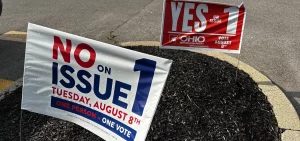News
Why Issue 1 is before Ohio voters Tuesday and what’s at stake
By: Karen Kasler | Statehouse News Bureau
Posted on:
COLUMBUS, Ohio (Statehouse News Bureau) — In November, voters in Ohio will be asked whether to pass a constitutional amendment to protect the right to an abortion. But Tuesday, they’ll decide on Issue 1, which would make it more difficult to pass a constitutional amendment in the first place.

“We’re talking about amending the Constitution probably for the rest of our lifetimes,” LaRose said. “That should be taken very seriously.”
Since 1912, Ohio’s constitution has required a simple majority to pass constitutional amendments proposed by state lawmakers or by citizens and groups. It’s has been amended 172 times, but only 19 of those amendments came from citizens or groups, including an out-of-state casino operator. The rest of the amendments came from state lawmakers.
Opponents suspected the timing from the start. Last summer, Ohio’s six-week abortion ban went into effect. Soon after, news went viral that a 10-year-old rape victim had gone to Indiana to get an abortion when Ohio doctors wouldn’t treat her. A lawsuit put that ban on hold, but groups mobilized to draft an amendment to Ohio’s constitution guaranteeing reproductive rights and abortion access, and started gathering signatures for a ballot issue.
In other Republican-dominated states, amendments and laws affirming abortion rights have passed, but by less than 60%. Republican supermajority lawmakers couldn’t get the higher threshold plan passed to put before voters on the state’s May primary ballot. So they came up with a new idea – an August special election. There was just one problem. Republicans had voted to eliminate most August special elections in a law they passed in December. LaRose, who had testified in support of that law, said it shouldn’t be an issue.
“As a course of action, normal course of doing business, yes, I do not believe in having elections in August as a normal way of holding elections. But if the state legislature decides to hold an election in August, it’s not unusual,” LaRose said.
Actually, it is unusual. The last time a statewide special election was held in August was in 1926.
A huge coalition formed to oppose raising the approval threshold to 60%. And while hundreds of those opponents descended on the Statehouse to pack committee meetings and to protest, Republican lawmakers continued to push forward. Though some, including Sen. Michael Rulli (R-Salem), had questions about why that percentage was chosen.
“So to prevent ‘mob rule’ of 50% plus one, you feel that 60%, perhaps because of these other states that chose the 60%, instead of the 75%?” Rulli asked one of the sponsors of the plan in a Senate committee hearing on it. “Because I’m a little bit gray on, like, why we wouldn’t have gone for 75% and just kept it at 60%.”
Republican lawmakers also added a provision dramatically increasing the workload for groups wanting to put amendments before voters. They’d have to get signatures from all 88 counties, not 44 as in current law. In a state as large and rural as Ohio, that would make it almost impossible for grassroots groups to get amendments on the ballot. LaRose had been opposed to that in the past, but he and Republican officeholders now backed it.
The resolution to put the 60% voter approval idea before voters on Aug. 8 passed easily in the Republican-dominated Senate in April. When it passed the House a few weeks later, Democrats and protestors in the chamber erupted with chants of “one person, one vote”. That became the name of the coalition that formed to oppose Issue 1.
Opponents of the plan filed suit, claiming it violated the law that banned most August special elections. In a party-line decision, the Ohio Supreme Court ruled the law didn’t apply to state legislators putting a constitutional amendment before voters.
The coalition for Issue 1 is primarily anti-abortion organizations, religious groups, gun rights advocates and the state’s major business groups concerned about a coming minimum wage amendment.
The opposition includes union groups but also smaller business groups, abortion rights advocates and gun control activists along with some religious groups. It also includes Ohio’s four living ex-governors and five former attorneys general from both parties. Democratic former state representative Mike Curtin has been one of the leading voices against Issue 1.
“It was a rush job on a monumental question, shifting a 111-year-old right that Ohioans have had to amend their state constitution to making it darn near impossible to do so,” Curtin said.
Despite the timing, Ohioans have shown up for early voting, with lines reported in some counties. Two weeks into early voting, the abortion rights amendment was certified for the fall ballot.
A $22 million TV and radio ad blitz from both sides of the issue has also likely heightened interest in this election. Anti-abortion and abortion rights groups as well as dark money have boosted that total. And nearly all of that money has come from outside Ohio.

